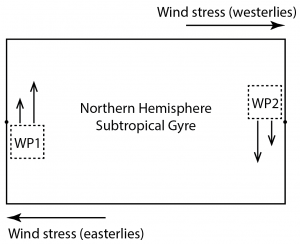39 Western Intensification
Why is the strong current that returns the interior Sverdrup transport located on the western side of an ocean basin?
First, note that western intensification is an observed phenomenon. Boundary layers on the western side of the ocean basin correspond to the strong Western Boundary Currents observed in the real ocean (the Gulf Stream, Kuroshio, Brazil, East Australia and Agulhas Currents). These currents play a very important role in the climate system due to their capacity for transporting heat across the subtropics.

As we noted, the western boundary current must have a relatively strong component of flow that is not geostrophic. There are numerous theories for what processes create this ageostrophic component, most involving lateral mixing of momentum (and vorticity).
One way of understanding why the boundary current is located on the western side of the basin is to think about angular momentum conservation for water parcels moving around the gyre. Let’s take the example of the subtropical gyre in a northern hemisphere ocean. We will consider two water parcels, WP1 flowing from south to north on the western side and WP2 flowing from north to south on the eastern side. There are two torques from external forces
- Torque from the wind-stress – a negative (clockwise) torque, that is approximately the same magnitude for WP1 and WP2.
- Torque from the frictional stress at the side walls of the basin. The frictional stress of the boundary acting on the fluid is directed opposite to the flow direction (southward for WP1 and northward for WP2). For both water parcels this results in a positive (counterclockwise) torque. The magnitude is proportional to the magnitude of the across-stream velocity gradient, i.e. the magnitude of
 .
.
Assuming that the water parcels enter and exit the boundary current with zero relative vorticity, we can understand that the change in planetary vorticity that they experience must be equal to the sum of the torques from the wind-stress and boundary stress. Assume also for simplicity a uniform depth ocean.
(1) WP1, flowing north to higher f experiences an increase in its planetary angular momentum (or vorticity). Since the wind-stress is a negative input, the (positive) frictional torque must be large – it must both overcome the negative wind stress curl, and then add some more positive torque to allow for the increase in latitude.
(2) WP2, flowing to the south, experiences a decrease in its planetary vorticity. The positive frictional torque cannot be as large here – it cannot completely cancel out the negative wind-stress torque. Only if the sum of the frictional and wind-stress torques remains negative can the water parcel flow to the south and decrease its planetary vorticity.
Thus, we conclude that the horizontal shear must be greater on the western side of the basin. For comparable boundary layer width, this means that the velocity just outside the boundary layer must be stronger in the western boundary layer than in the east.
Mini-lecture for class:
Media Attributions
- WesternIntensification © Susan Hautala is licensed under a CC BY-NC-SA (Attribution NonCommercial ShareAlike) license

